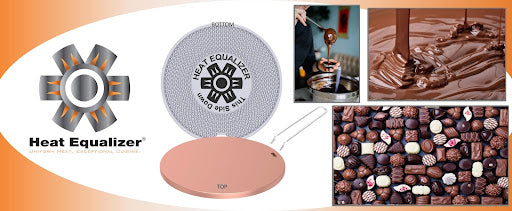Explore the benefits of using a heat diffuser plate as a part of your chocolate work.
Working with chocolate is a rewarding experience for any chocolate lover or aspiring chocolatier.
Whether you're creating indulgent truffles, decadent desserts, or delicate decorations, achieving the perfect texture and appearance of chocolate is essential.
Here’s why using the Heat Equalizer diffuser can simplify your chocolate work and process
The Challenges of Working with Chocolate
Understanding these challenges is crucial to achieving the desired results in your chocolate creations. Here are the issues:
- Delicate nature of chocolate
- Risks of overheating or uneven heating: When chocolate is overheated or heated unevenly, it can lead to several issues, including:
- Graininess
- Separation
- Scorching
- Importance of precise temperature control
Benefits of Using a Heat Equalizer Heat Diffuser Plate for Chocolate Work
Here are the pros (absolutely no cons) to using a diffuser for your chocolate work:
Even Heat Distribution
- A diffuser plate plays a crucial role in ensuring even heat distribution when working with chocolate. By placing the diffuser plate between the heat source and the chocolate, it helps eliminate hot spots that could potentially damage the delicate chocolate.
- Even heat distribution is essential for melting chocolate uniformly and avoiding overheating. When chocolate is exposed to uneven heat, some parts may melt too quickly while others remain solid. The result is uneven texture and potentially ruining the chocolate. With a diffuser plate, the heat is evenly dispersed, allowing the chocolate to melt uniformly and consistently.
Precise Temperature Control
- A diffuser plate plays a vital role in achieving precise temperature control, especially when tempering chocolate. Temperatures that are too high or too low can result in untampered chocolate, affecting its texture and appearance. By using a diffuser plate, you have better control over the heat and can make precise adjustments to reach the optimal temperature for tempering.
- Maintaining the right temperature range is essential for achieving perfectly tempered chocolate. Tempering involves heating and cooling the chocolate to promote the formation of stable cocoa butter crystals, giving the chocolate a glossy finish and a satisfying snap. With a diffuser plate, you can maintain a steady and consistent temperature, allowing the chocolate to cool and set properly without crystallizing prematurely.
Melting and Tempering Chocolate
Here are step-by-step Instructions for melting and tempering chocolate:
- Start by finely chopping the chocolate into small, uniform pieces. This ensures even melting and helps the chocolate melt more quickly and smoothly.
- Place the chopped chocolate in a heatproof bowl or a double boiler.
- Set up your gas stove with the heat diffuser plate positioned between the burner and the container holding the chocolate.
- Turn the heat to low or medium-low, allowing the chocolate to melt gradually. Stir the chocolate occasionally with a heat-resistant spatula to promote even melting.
- As the chocolate begins to melt, continue stirring gently until it reaches the desired consistency. Be careful not to overheat or burn the chocolate.
- Once the chocolate is fully melted, it's time to temper it. This involves raising and lowering the temperature to encourage the formation of stable cocoa butter crystals.
- Remove the bowl from the heat source and place it on a heatproof surface. Begin cooling the chocolate by stirring continuously, allowing the temperature to drop.
- When the chocolate reaches a specific temperature (varying depending on the type of chocolate), return the bowl to the heat source for a brief moment to raise the temperature slightly.
- Repeat the process of cooling and heating until the chocolate reaches the desired tempering temperature.
- Once the chocolate is tempered, it is ready to be used for dipping, molding, or any other chocolate work.
Wrapping It Up

Working with chocolate is much simpler and way less stressful with a heat diffuser. You’ve got to try it out and take your chocolate skills to the next level. Take a look at the Products Page to learn more.





Leave a comment
This site is protected by hCaptcha and the hCaptcha Privacy Policy and Terms of Service apply.